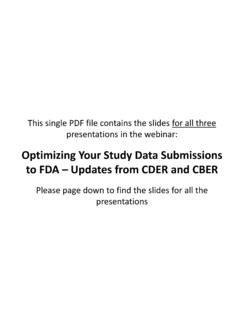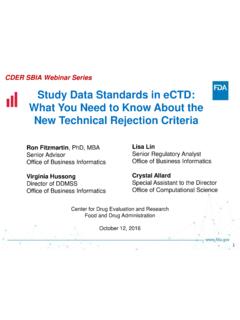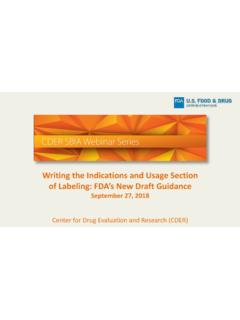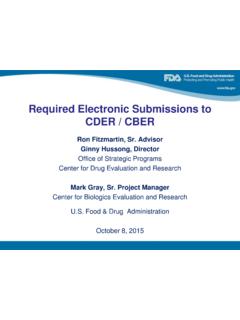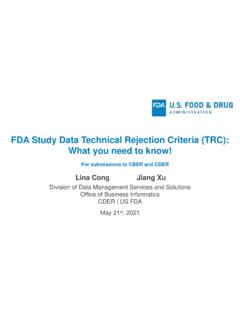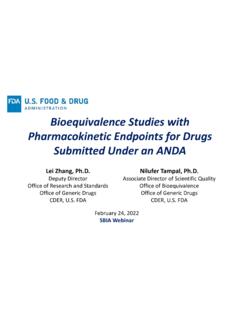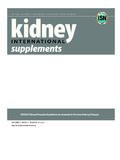Transcription of Postmarketing Drug Safety and Inspection Readiness
1 Postmarketing Drug Safety and Inspection Readiness June 19, 2018. Center for Drug Evaluation and Research (CDER). Small Business and Industry Assistance (SBIA) Webinar United States Food and Drug Administration (FDA). CDER / Office of Compliance Office of Scientific Investigations (OSI). Division of Enforcement and Postmarketing Safety (DEPS). Postmarket Safety Branch (PSB). 1. This one file contains all the slides used in the AFTERNOON sessions of the webinar. 2. Lunch Break 3. Session 3: Inspection Readiness 4. Outline ORA. Inspection Readiness : PADE Inspections REMS. 5. What does an Inspection look like? H CTOR J. COL N TORRES, MPH. LIEUTENANT COMMANDER, UNITED STATES PUBLIC HEALTH SERVICE. BIORESEARCH MONITORING PROGRAM EXPERT. OFFICE OF BIORESEARCH MONITORING OPERATIONS. OFFICE OF REGULATORY AFFAIRS | FDA. 6. Objectives Provide an overview of the FDA BIMO program and the role of the Office of Bioresearch Monitoring Operations. Provide an overview of the general elements of an FDA Inspection and the basics of a BIMO.
2 Inspection . 7. FDA Structure (field operations). 8. FDA Structure (field operations). 9. Office of Bioresearch Monitoring Operations (OBIMO). OBIMO oversees all domestic and foreign field inspectional operations related to the BIMO Program, including all clinical and nonclinical research conducted in support of preapproval, licensing, premarket and marketing clearance applications submitted to the agency for products regulated by all FDA product centers. 10. BIMO Program Inspection Goals Protect the rights, Safety and welfare of subjects involved in FDA-regulated clinical and nonclinical trials;. Verify the accuracy and reliability of clinical and nonclinical trial data submitted to FDA in support of research or marketing applications;. and Assess compliance with statutory requirements and FDA regulations governing the conduct of clinical and nonclinical trials. 11. BIMO Program Inspections Establishment Types Establishments inspected include Sponsors, Monitors, Contract Research Organizations (CRO), Clinical Investigators, Institutional review Boards (IRB), Radioactive Drug Research Committees (RDRC), In Vivo and In Vitro Bioequivalence/Bioanalytical Clinical and Analytical Sites (BEQ), and Nonclinical Laboratories (GLP).
3 It also includes Postmarket Adverse Drug Experience (PADE) reporting and Risk Evaluation and Mitigation Strategies (REMS) inspections, both of which are post approval activities. 12. BIMO Program Inspections Inspection Basis Surveillance - Inspection is conducted as a routine assignment with no other indicators of non- compliance. Compliance - Inspection is conducted to investigate potential violations that have not already resulted in an official agency action. Consumer Complaint - Inspection is conducted in direct follow-up to a consumer complaint. 13. Pre-announced vs Unannounced The following inspections will be pre- announced unless otherwise instructed in the Inspection assignment: Clinical Investigators, Sponsors/CROs, IRBs, RDRCs The following inspections will be unannounced unless otherwise instructed in the Inspection assignment: BEQ clinical, BEQ analytical, GLP, REMS, PADE. All international inspections are pre-announced 14. Opening Interview Present Credentials 15.
4 Opening Interview Issue FORM FDA 482 Notice of Inspection 16. Opening Interview Describe the scope and basis of the Inspection ( routine surveillance, for cause, compliance follow up Inspection , etc.). Inspections should be sufficient in scope to cover special instructions in the assignment and to determine if the site's practices and procedures comply with the appropriate regulations. 17. Opening Interview The FDA investigator will offer to have daily discussions regarding the Inspection progress. 18. Refusal A refusal is refusal to permit an Inspection or prohibiting the FDA investigator from obtaining information to which FDA is entitled under the law. In the case of drug inspections, Inspection refusals, as well as delaying, denying, or limiting the ability to conduct the Inspection , may cause a drug to be deemed adulterated under Section 501(j) of the FD&C Act [21 351(j)]. 19. Inspectional Scope Compliance Program (CP). Assignment memo from center Investigations Operations Manual (IOM).
5 20. Inspectional Scope The CPs are based upon the establishment type to be inspected and provide instruction on what to cover during the Inspection . The assignment memo includes specific instructions regarding studies/protocols and/or products to be covered during the Inspection . The IOM provides general instruction on inspections and specific information on BIMO. 21. Inspectional Scope 22. Good Documentation Practices ALCOA. Accurate Legible Contemporaneous Original Attributable 23. Form FDA-483 Inspectional Observations Upon completion of the Inspection and before leaving the premises, the FDA investigator will provide to the highest management official available the inspectional findings on a form FDA 483 - Inspectional Observations. The issuance of written inspectional observations is mandated by law and ORA. policy. 24. Form FDA-483 Inspectional Observations 25. Form FDA-483 Inspectional Observations The FDA 483, Inspectional Observations is intended for use in notifying the inspected establishment's top management in writing of significant objectionable conditions, relating to products and/or processes, or other violations of the FD&C Act and related Acts which were observed during the Inspection .
6 26. Inspection Classification Upon completion of the Inspection , ORA. recommends an initial Inspection classification. o No Action Indicated (NAI) - No objectionable conditions or practices were found during the Inspection (or the significance of the documented objectionable conditions found does not justify further FDA action). 27. Inspection Classification Voluntary Action Indicated (VAI) - Objectionable conditions were found and documented but the District and/or Center is not prepared to take or recommend any of the regulatory (advisory, administrative, or judicial) actions since the objectionable conditions do not meet the threshold for regulatory action Official Action Indicated (OAI) - Objectionable conditions were found and regulatory action should be recommended 28. Inspection Classification The assignment issuing Center has final classification authority. The centers will determine and assign the final classification for the Inspection , and initiate regulatory actions, if warranted.
7 29. Resources BIMO Program CPGMs 30. Inspection Readiness : PADE. Inspections Marcia Gelber, RPh Consumer Safety Officer PADE Compliance Team 31. Objectives 1. Describe the PADE Inspection process 2. Explain how FDA uses Inspection information 3. Recognize best practices for PADE inspections 32. PADE Inspection Coverage Written procedures Product list (approval date, status, etc.). Organization, roles and responsibilities Late or missing periodic reports Safety Contracts Late or missing / Agreements annual reports Business partners Late, missing, incomplete, or inaccurate Training documents Waivers 15-day reports Confirmations for Root cause analyses and ADEs from electronic submissions corrective actions for deviations all sources 33. PADE Inspection Trends: PADE Citations on Form FDA 483 (FY2015-FY2017). 34. Common Inspection Observations 1. Failure to develop adequate written procedures for the surveillance, receipt, evaluation, and reporting of Postmarketing adverse drug experiences 21 CFR (b).
8 21 CFR (b). 21 CFR (a). 35. Written Procedures Must Address . Surveillance Receipt Evaluation Reporting Account for all ADE info Seriousness 15-day Alert sources Initial Expectedness Reports Follow-up Relatedness Spontaneous Non-expedited individual case Solicited Receipt from ADEs from any Safety reports any source source (ICSRs). Internet sources (firm-sponsored) Aggregate Follow-up Literature procedures Reports and more! All info must be submitted electronically 36. Common Inspection Observations 2. Failure to submit all adverse drug experiences that are both serious and unexpected to FDA. within 15 calendar days of initial receipt of the information 21 CFR (c)(1)(i). 21 CFR (c)(1)(i). 21 CFR (c)(1)(i). 37. Common Inspection Observations 3. Failure to report each adverse drug experience not reported under 21 CFR (c)(1)(i) or 21. CFR (c)(1)(i) at quarterly intervals for three years from the date of approval of the application, and then at annual intervals 21 CFR (c)(2)(i).
9 21 CFR (c)(2)(i). 38. What makes a good Corrective Action Plan? Investigate and identify actual and potential causes of non-compliance Correction- Corrective Action- Correct instances of non- Eliminate causes of non- compliance compliance Document! Preventative Action- Assessment- Implement measures to Verify timeliness of actions prevent future occurrences and effectiveness of plan 39. Four Reasons to Submit a Complete and Timely Written Response 1. May be considered in an FDA compliance decision 2. Demonstrates your acknowledgment and understanding of the observations to the FDA. 3. Demonstrates your commitment to correct the observations to the FDA. 4. Establishes credibility with the FDA. Regulatory Procedures Manual at: 40. Points to Consider for Written Responses 1. Include a commitment from senior leadership 2. Address each observation separately 3. Note whether you agree or disagree 4. Provide both corrective and preventive actions 5. Provide both completed and planned actions 6.
10 Provide timelines for completion 7. Provide a method of verification or monitoring the effectiveness of the actions 8. Submit documentation (training, SOPs, CAP, records). 9. SUBMIT THE RESPONSE WITHIN 15 WORKING DAYS. 41. What if I miss the 15-day deadline? We acknowledge receipt of your written response dated [Month dd, yyyy,] to the Form FDA 483 but note that this response was received past the fifteen (15) business days from close of the Inspection . Thus, while we have reviewed the response, we have not included a discussion of the response in this letter as per the Commissioner's Enforcement Initiative announced August 11, 2009. 42. Take Away Messages Adequate preparation for an FDA Inspection may result in a more positive outcome Remember to refer back to PADE regulations whenever possible to ensure that your pharmacovigilance activities meet the regulatory requirements Remember to submit a well-reasoned, complete, and timely written response 43.
